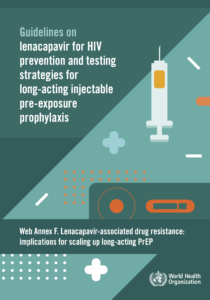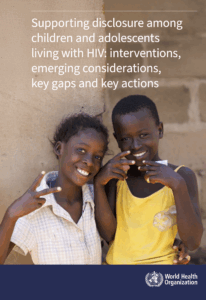IAS 2025: WHO guidelines: major updates on injectables, AHD, breastfeeding, infant prophylaxis and peer support
2 August 2025. Related: Conference reports, Guidelines, IAS 13th Kigali 2025.


WHO panel discussion at IAS 2025
Simon Collins, HIV i-Base
A satellite meeting at the start of IAS 2025 introduced important new WHO guidelines on long-acting injectable PrEP and significant updates to other important aspects of HIV care. [1]
This session was introduced by Meg Doherty, Director of Global HIV, Hepatitis and STIs at WHO and recently appointed Director of Science, Research and Evidence and Quality for Health. The guidelines have been designed to support simplification, greater integration and better use of limited resources with a focus on people from key populations and others who are often left behind.
This session included main presentations on each section followed by an open Q&A discussion.
Long-acting injectable drugs and HIV testing
 Michelle Rodolph introduced new GRADE-based guidelines on injectable lenacapavir for PrEP and optimisation of HIV testing for long-acting products. [2, 3]
Michelle Rodolph introduced new GRADE-based guidelines on injectable lenacapavir for PrEP and optimisation of HIV testing for long-acting products. [2, 3]
The main recommendation is to include injectable lenacapavir as an option for PrEP as part of an HIV prevention strategy. Importantly, this will support access programmes that are in the beginning of planning stages, even before widespread access to lenacapavir has become available.
It also includes recommendations to simplify HIV testing when using long-acting PrEP, including injectable cabotegravir-LA and the dapivirine ring. For example, rapid Ag/Ab HIV tests are recommended rather than viral load tests for baseline and ongoing monitoring with long-acting injections.
Although the guidelines recognised that self-testing could increase flexibility and frequency of testing, a lack of evidence meant that self-testing is only recommended for oral PrEP, the dapivirine ring and for PEP.
All approved PrEP options can be safely used during pregnancy. Based on 193 pregnancies that occurred in the PURPOSE 1 study, the systematic review found that “lenacapavir probably has little to no effect in terms of adverse pregnancy and birth outcomes compared with oral TDF/FTC (moderate certainty of evidence).”
Although two HIV seroconversions in the phase 3 studies developed the N74D capsid mutation, this is only highlighted as a concern for surveillance.
The guidelines stress that there are no concerns about any PrEP drugs having a significant interaction with either hormonal contraception or gender-affirming hormone therapy (GAHT).
However, lenacapavir is metabolised by CYP3A4 pathway and interactions with CYP3A4 inducers that could reduce lenacapavir include TB antibiotics (rifabutin, rifampicin and rifapentine) and anticonvulsants (carbamazepine, phenobarbital and phenytoin). Inhibition of CYP3A4 by lenacapavir has the potential to increase drug levels of ketamine and PDE-5 inhibitors for erectile dysfunction which might need dose adjustment.
The guidelines also address cost-effectiveness and considerations for implementation.
This 60-page stand-alone document was primarily to develop prevention programmes in low- and middle-income countries. It includes seven additional appendices that include the evidence reviews.
ART, advanced HIV disease, STIs and mpox
Nathan Ford then presented updated recommendations for clinical management, including injectables.
These changes have been published in a separate 14-page document, rather than being added to the current consolidated HIV guidelines. [4]
This document covers HIV, mpox, STIs and noncommunicable diseases. It is also about sustaining services for HIV, viral hepatitis and STIs given the changes in international funding since 20 January.
Selected recommendations are included below but please check the full document for details.
Optimising ART
- Darunavir + ritonavir is now the preferred boosted protease inhibitor (PI).
- Atazanavir + ritonavir or lopinavir + ritonavir can be used as alternative boosted PIs.
- TDF or TAF + xTC is preferred the NRTI backbone for adults, adolescents and children weighing more than 30 kg. This is even if TDF or AZT were previously used.
- Abacavir + 3TC or TAF + xTC is recommended for children weighing less than 30 kg.
- Dolutegravir (DTG) + 3TC dual ART can be a switch option if viral load is undetectable and without active HBV.
- Injectable CAB/RPV-LA is an alternative switching option if viral load is undetectable and without active HBV.
Advanced HIV disease (AHD)
A new recommendation is for CD4 testing to be the preferred way to identify and manage AHD. This is particularly important because access to CD4 testing in routine HIV management has steadily been reduced over the last ten years.
This was largely linked to pressure from funders to reduce costs, because viral load is more important once on effective ART. However, this was done without considering the impact this would have on the management of advanced HIV.
It also led to the majority of new HIV diagnoses in some countries not having a baseline CD4 count which will add to the already impossible challenge of managing people who have been forced to interrupt ART since 20 January 2025. While many people who were diagnosed in early infection might have a sufficiently high CD4 count for this to be a manageable risk, those who were diagnosed in late stage infection will be at a significantly higher risk of rapid HIV progression.
WHO clinical staging can be used when CD4 testing is not available.
TB, KS, integrated care and peer support
- Preferred TB preventive therapy is 3 months of rifapentine and isoniazid (3HP). Alternatives are six or nine months of isoniazid (6H or 9H). Other WHO recommended regimens such as 3HR, 1HP, 4R and 6Lfx may be used in special circumstances.
- Paclitaxel or pegylated liposomal doxorubicin is now recommended to treat Kaposi’s Sarcoma (KS).
- The guidelines recommend routinely integrating other services with HIV care: diabetes, hypertension, mental health care (including depression and anxiety), alcohol use disorders and sexual health. For example, 1 in 10 people living with HIV in sub-Saharan Africa have diabetes and 1 in 4 have hypertension. A recent meta-analysis reported even higher rates of mental health complications globally. [5]
- Evidence on interventions to support adherence has also been updated with the notable recommendation on the importance of peer support.
Breastfeeding, infant prophylaxis and HIV disclosure
 Francoise Renaud presented the revised recommendations on infant prophylaxis and breastfeeding, and new guidelines on supporting HIV disclosure among children and adolescents,
Francoise Renaud presented the revised recommendations on infant prophylaxis and breastfeeding, and new guidelines on supporting HIV disclosure among children and adolescents,
This includes, in the context of viral suppression on ART and post-natal prophylaxis, recommending a rights-based approach on the choice to breastfeed, even when national programmes recommend formula feeding. This might include enhanced support for adherence and retention in care.
Infant prophylaxis is based on background risk.
- At low HIV risk, prophylaxis uses a single drug for the first six weeks. Nevirapine is preferred, with dolutegravir* or 3TC as alternatives.
- At high risk, prophylaxis uses a three-drug regimen for six weeks. Abacavir, 3TC and dolutegravir* (pALD) is the preferred option. Single drug prophylaxis (as above) should then continue while breastfeeding or until the mother’s viral load becomes undetectable.
Paediatric ALD* dosing recommendations now include all neonates born at term and infants weighing >3kg.
*Dolutegravir is only recommended in full-term babies (>37 weeks).
This talk also introduces a new 40-page WHO resource on supporting HIV disclosure among children and adolescents living with HIV. [6].
HIV and mpox
Remco Peters provided an update on 148-page guidelines produced in May 2025 on the clinical management and prevention of mpox. [7]
Recommendations relating to HIV include early HIV testing for all suspected and confirmed mpox cases. Also, rapid initiation of ART (including same-day) in anyone living with HIV who is not currently on treatment.
It is also important that ART should not be stopped in anyone already on ART. Viral load should be checked if not recent (<1 year).
This guideline is an update of new research and developments since the interim mpox guidelines were first published in 2022.
STI guidelines
WHO has also recently updated guidelines on sexually transmitted infections. [8]
These include two new sections of the upcoming consolidated guidelines on STI prevention and care. These are the 50-page ‘Guidelines for the management of asymptomatic STIs’ and a 56-page ‘Recommendations on the delivery of health services for STI prevention and care’. [9, 10]
STI screening is routinely recommended for N. gonorrhoeae and/or C. trachomatis in various asymptomatic populations at higher risk depending on prevalence and rates of exposure and partner numbers.
comment
These important guidelines are welcomed and will help improve many services and standards of care. These resources have been produced during a time when WHO is being forced to restructure due to uncertain funding.
The early inclusion of injectable PrEP should help support access programmes as they are developed.
The future of HIV prevention was a major topic at the conference, both for new advances such as injectable formulations of PrEP but also for continued funding of all aspects of HIV prevention, as highlighted in the Kigali Call to Action. [11]
Other headline news – though still not yet widely reported by other media – include taking a rights-based approach, in the context of effective ART and post-natal prophylaxis, to support the option to breastfeed, even in high-income settings where this is not national policy.
It is also good to see the official recognition for the roles of peer advocates in supporting people on ART and the resources to support disclosure in young people living with HIV.
It is disappointing that WHO guidelines for oral PrEP have not been updated to include everyone starting with a double dose, wider use of TAF/FTC or 2:7 event-based dosing for women and transgender and non-binary people.
In reply to a question during the discussion, Michelle Rodolph commented that this does not mean that these options are not effective but due to a lack of the level of evidence needed by WHO to make recommendations.
Given RCTs or even large observational studies to look at these areas are neither ongoing nor planned and so will never be available, WHO could comment on the strong supportive evidence from PL/PD and modelling studies.
References
- What’s new in WHO guidelines: Advancing prevention, testing, and treatment for impact and sustainability. IAS 2025. WHO satellite meeting. IAS 2025, 13-17 July 2025. SAT11. (14 July 2025).
https://programme.ias2025.org/Programme/Session/202 (programme)
https://conference.ias2025.org/media-1100-whats-new-in-who-guidelines-advancing-prevention-testing-and-treatment-for-impact-and-sust (webinar with login) - WHO. Guidelines on lenacapavir for HIV prevention and testing strategies for long-acting injectable pre-exposure prophylaxis. (14 July 2025).
https://www.who.int/publications/i/item/9789240111608 - WHO. WHO recommends injectable lenacapavir for HIV prevention. (14 July 2025).
https://www.who.int/news/item/14-07-2025-who-recommends-injectable-lenacapavir-for-hiv-prevention
https://iris.who.int/bitstream/handle/10665/381896/B09471-eng.pdf (PDF) - WHO. Overview of WHO recommendations on HIV and sexually transmitted infection testing, prevention, treatment, care and service delivery. (14 July 2025).
https://www.who.int/publications/i/item/B09471 - Hu FH et al. Prevalence of mental health problems in people living with HIV: a systematic review and meta-analysis. Psychol Health Med. 2025 Mar;30(3):397-413. doi: 10.1080/13548506.2024.2424998.
- WHO. Supporting disclosure among children and adolescents living with HIV: interventions, emerging considerations, key gaps and key actions.
https://iris.who.int/handle/10665/381852 - WHO. Clinical management and infection prevention and control for mpox: living guideline. (May 2025).
https://www.who.int/publications/i/item/B09434 - WHO press release. WHO expands guidance on sexually transmitted infections and reviews country progress on policy implementation. (26 July 2025).
https://www.who.int/news/item/26-07-2025-who-expands-guidance-on-sexually-transmitted-infections-and-reviews-country-progress-on-policy-implementation - WHO. Guidelines for the management of asymptomatic sexually transmitted infections 9 July 2025 | Guideline. (9 July 2025).
https://www.who.int/publications/i/item/9789240104907 - WHO. Recommendations on the delivery of health services for the prevention and care of sexually transmitted infections. (14 July 2025).
https://www.who.int/publications/i/item/9789240113114 - The Kigali Call to Action: sign-on to global leaders. HTB (1 July 2025).
https://i-base.info/htb/51418

